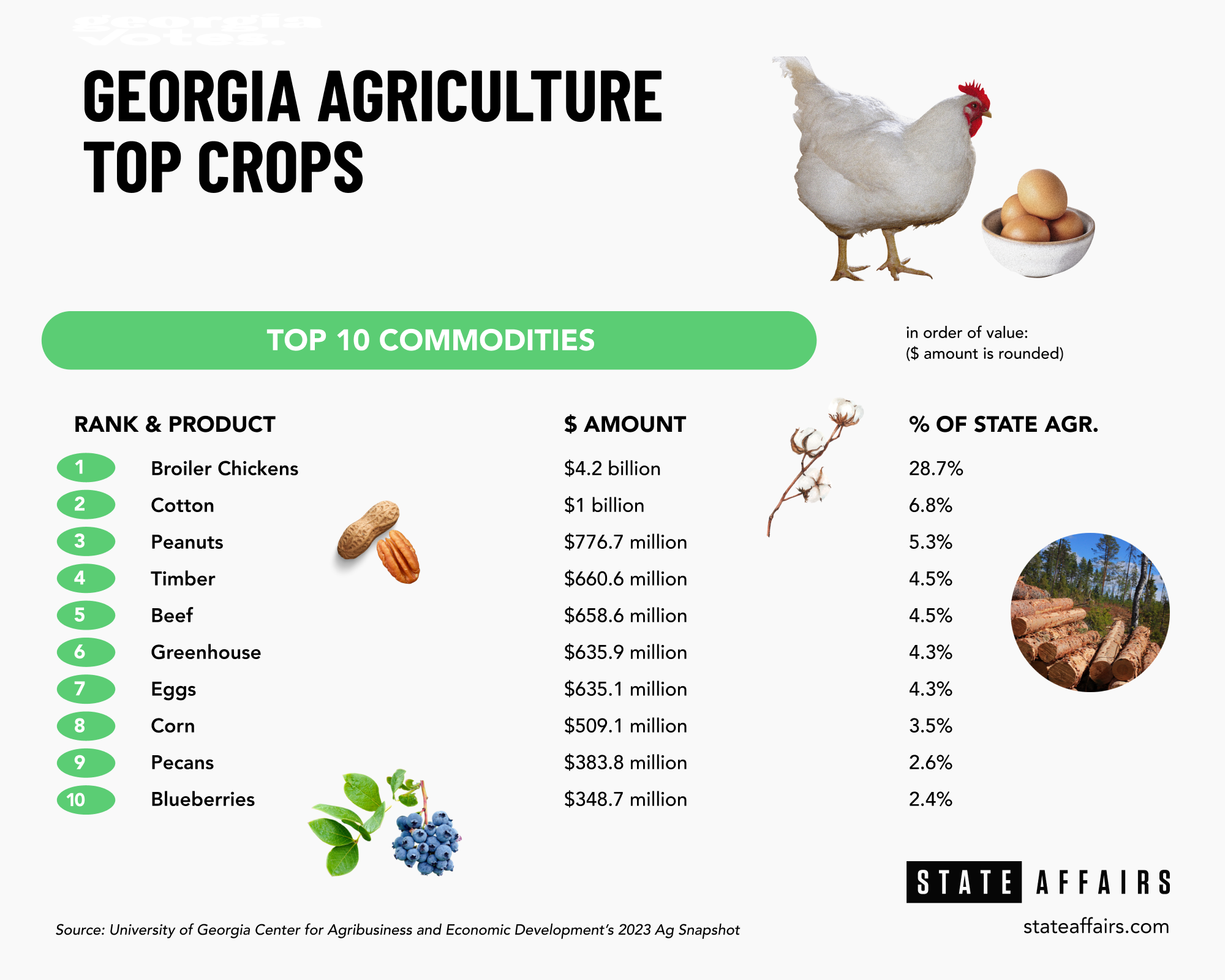12+ Top Agricultural Items For Georgia Farmers

Georgia, known for its rich agricultural history and diverse landscape, offers a wide range of opportunities for farmers to cultivate various crops and raise livestock. The state's climate, which varies from the coastal plains to the mountainous regions, allows for the production of a broad spectrum of agricultural products. This diversity is not only beneficial for local consumption but also contributes significantly to the national and international markets. For Georgia farmers, understanding the top agricultural items can help in making informed decisions about what to produce, based on market demand, climate suitability, and profitability.
Agricultural Overview of Georgia

Georgia’s agricultural sector is a significant contributor to the state’s economy. The industry encompasses a variety of products, including crops, livestock, and related activities such as forestry and aquaculture. The state’s agricultural production is influenced by its geographical location, which allows for multiple harvests in a year due to its mild winters and long growing season. This advantage, combined with advanced farming techniques and technology, positions Georgia as a leader in agricultural production in the United States.
Top Crops for Georgia Farmers
Georgia farmers have a multitude of crop options that are well-suited to the state’s climate and soil conditions. Among the top crops are:
- Peanuts: Georgia is the leading producer of peanuts in the United States. The crop thrives in the state’s sandy soils and is primarily used for peanut butter, snack nuts, and seed.
- Cotton: Cotton is another major crop in Georgia, with the state ranking among the top cotton-producing states in the country. It is used in textile production.
- Corn: Used for livestock feed, ethanol production, and human consumption, corn is a versatile crop that grows well in Georgia’s climate.
- Soybeans: Soybeans are a valuable crop for oil production and as a protein source in animal feed. Georgia’s farmers take advantage of the crop’s adaptability to different soil types.
- Tobacco: Although its production has declined in recent years, tobacco remains an important crop in certain parts of Georgia, known for its high quality.
- Blueberries: Georgia is renowned for its blueberry production, with the crop being a significant contributor to the state’s fruit production. The mild winters and acidic soils make it an ideal place for blueberry cultivation.
- Pecans: As the leading producer of pecans in the world, Georgia’s pecan industry is a substantial part of its agricultural sector, with the nuts being used in baking, snacks, and as a gourmet food item.
Livestock Production in Georgia
Beyond crops, Georgia is also home to a thriving livestock industry, which includes:
- Broilers (Chickens): Georgia is the top producer of broilers in the United States, with poultry being a major sector of the state’s agricultural economy.
- Eggs: The state’s poultry farms also produce a significant number of eggs, both for local consumption and for distribution across the country.
- Cattle: Beef and dairy cattle are raised in Georgia, with the state’s pasturelands and feedlots supporting a sizable herd.
- Hogs: Although less prominent than poultry, hog production is still an important part of Georgia’s livestock industry.
| Crop/Livestock | Annual Production Value |
|---|---|
| Peanuts | $567 million |
| Cotton | $434 million |
| Corn | $243 million |
| Soybeans | $173 million |
| Broilers | $4.7 billion |

Future Implications and Challenges

The future of agriculture in Georgia is promising, with opportunities for growth in both traditional and emerging sectors. However, farmers must also contend with challenges such as climate change, water management, and maintaining soil health. Technological advancements, including precision agriculture and vertical farming, are expected to play a significant role in addressing these challenges and improving productivity.
Sustainability and Technology
Sustainability is becoming increasingly important in agricultural practices, with a focus on reducing the environmental footprint of farming operations. Technologies such as drones, satellite imaging, and advanced irrigation systems are being adopted to optimize water and fertilizer use, reduce waste, and promote more efficient farming practices.
What are the most profitable crops for small-scale farmers in Georgia?
+For small-scale farmers, crops like blueberries, pecans, and specialty vegetables can be highly profitable due to their high demand and price per unit. However, profitability depends on factors like market access, production costs, and the farmer's ability to manage the operation efficiently.
How can Georgia farmers adapt to climate change?
+Adapting to climate change involves implementing practices that enhance resilience, such as using drought-resistant crop varieties, adopting conservation tillage to improve soil health, and integrating climate-smart agricultural practices into farm management plans.
In conclusion, Georgia’s agricultural sector is diverse and robust, offering a wide range of opportunities for farmers. By focusing on high-demand products, adopting sustainable practices, and leveraging technology, Georgia farmers can continue to thrive and contribute to the state’s economic growth.

